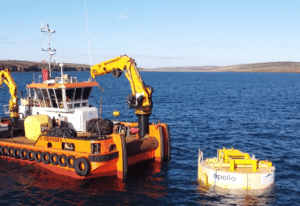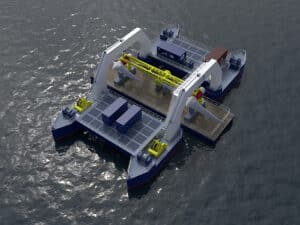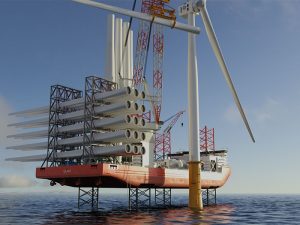
Danish Yachts building carbon fiber SWATH for wind farm service role
Written by Nick Blenkey A Danish shipyard that specializes in superyachts is entering the commercial market with a wind farm service vessel that will see its expertise in carbon fiber hull construction applied to a SWATH (Small Waterplane Area Twin Hull) vessel.
A Danish shipyard that specializes in superyachts is entering the commercial market with a wind farm service vessel that will see its expertise in carbon fiber hull construction applied to a SWATH (Small Waterplane Area Twin Hull) vessel.
Danish Yachts says that its SeaStrider line of designs for high speed passenger transport will be the first carbon fiber SWATH’s to be built.
The first boat under construction in the range is designed to carry service personnel and cargo to offshore wind farms, and for transit between the wind towers. The vessel has already been tank tested to significant wave heights, permitting operation in almost all weather conditions, while maintaining safety and comfort. This version is designed to an overall length of 25 meters, providing space for 24 passengers and five crew over a range of around 500 nautical miles.

Shipowner Fredrik Odfjell of Offshore Windservice, says “We are extremely pleased to be working with Danish Yachts in the build of this series of wind turbine service vessels, with their depth of experience and knowledge in innovative carbon construction. A key factor for our support fleet is stability in a large seaway and the ability to transfer between the towers at speed in severe conditions, vastly reducing down time for the maintenance teams while on operational duties at the wind farms.”
The craft is to carry initially the construction teams, and then the maintenance and emergency repair teams to and from the offshore windmill turbine farms efficiently, safely and in total comfort.
The twin hull configuration with a beam of 10.6 metres, in itself provides more lateral stability. SeaStrider is easy to maneuver in high winds using precision controls to ensure safe placement of the turbine maintenance teams onto the wind tower dock at the base of the turbine. In addition for passenger and crew safety of transfer to the platform, the vessel is to be fitted with the base for use of a gyro transfer gangway on the transom.
This SWATH design has a clear bridge area with good all round vision, boasts comfortable seating and dining areas for passengers, at the same time providing comfortable crew sleeping quarters with three single and one double cabin.
SeaStrider is fitted with specially designed brackets for a single point lift, providing a “one wire” lift either on land or on a larger platform at sea. Once ashore, SeaStrider can be placed on a flat surface, without the need for any supports or a cradle.
A key factor for SeaStrider is the innovative construction techniques for which Danish Yachts is renowned. Lightweight carbon fiber build maximizes fuel efficiency, and with less requirement for fuel capacity, this allows more room for passengers and cargo. This method of construction guarantees an extremely strong vessel at a reduced weight, ensuring minimum impact when mooring up at the wind tower.
Henry Kierkegaard, CEO of Danish Yachts said, “We are delighted to be working on this project to provide a new generation of service vessels to the offshore wind turbine industry. It is significant that this is the first ever service vessel to be designed and built with an active ballast tank system • this means that the passenger experience on board will be even more stable on transfer to and from the wind towers.”
One of the unique building techniques that has been developed and refined in the Danish Yachts’ shipyard in Skagen is the use of carbon fiber and epoxy infusion. This technology allows for very light and strong structures without any form of emissions to the environment during construction. Designs are evaluated and rigorously scrutinized to ensure the most efficient use of resources.
Danish Yachts was one of the first shipyards in Denmark to have achieved the ISO 14001 environmental accreditation. In addition, it holds ISO 9001 and safety management system accreditation, DS/OHSAS 18001.
February 10, 2012





Leave a Reply
You must be logged in to post a comment.